In the vast landscape of road signs that guide, instruct, and inform drivers, the yield sign stands out with its unique shape and distinct message. An essential part of the traffic regulation system, the yield sign has a history and purpose that every driver should be familiar with.
This guide delves deep into the significance, design, and variations of the yield sign across different countries, ensuring that readers understand its role in ensuring road safety. From its historical origins to the symbolism behind its design and from its positioning on roads to the safe practices associated with it, we journey through the multifaceted aspects of this seemingly simple road sign.
Whether you’re a seasoned driver or someone just getting behind the wheel, this comprehensive exploration provides valuable insights into the world of traffic regulations and the integral role the yield sign plays in it. Join us as we navigate the ins and outs of the yield sign and its contribution to safe driving practices worldwide.
What’s Yield Sign? Meaning and Definition
A yield sign is a regulatory traffic sign used to instruct drivers to slow down and prepare to stop if necessary, giving the right-of-way to pedestrians and oncoming traffic. The primary purpose of this sign is to ensure that traffic flows smoothly and safely, especially at intersections where two roads merge or intersect.
Road signs serve as the silent custodians of our highways and streets, guiding, warning, and instructing drivers and pedestrians alike. These symbols and emblems, often taken for granted, play an indispensable role in maintaining order on the roads and ensuring the safety of all road users. They communicate essential information, helping to reduce the risk of accidents, regulate traffic flow, and inform about upcoming conditions or situations that require special attention.
One such emblematic figure in the world of road signs is the yield sign. Far from being just another sign among the myriad symbols dotting our roads, the yield sign carries with it a specific and critical message: slow down, observe, and proceed with caution. It underscores the principle of giving way and coexisting harmoniously with other road users. This sign acts as a linchpin in the broader road safety mechanism, reminding us that sometimes, safety is not just about stopping but about knowing when to give way.
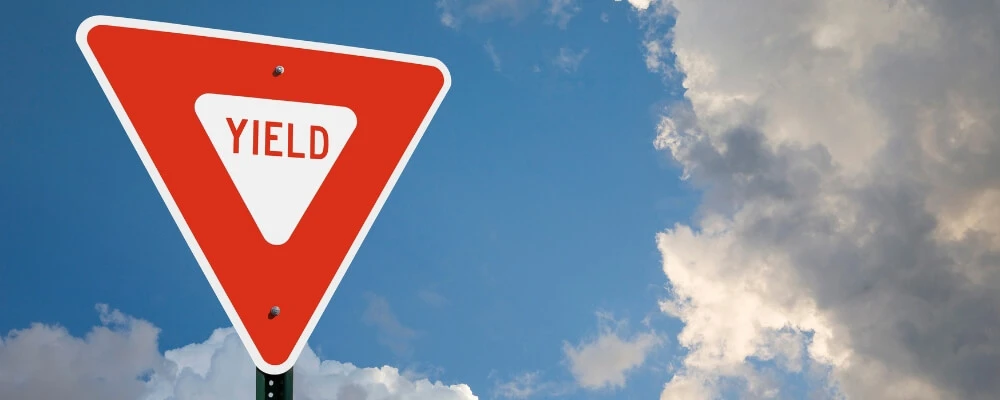
History and Evolution Of Yield Sign
The history of the yield sign is both a tale of design evolution and a reflection of changing traffic dynamics and road safety priorities.
1. Origins of the Yield Sign
The yield sign traces its origins to the United States in the late 1950s. The first yield sign was introduced in Tulsa, Oklahoma, in 1950 by Clinton Riggs, a police officer who later became a Tulsa police commissioner.
Riggs designed the sign to solve a specific problem: how to maintain a steady flow of traffic at intersections without causing unnecessary stops or dangerous collisions. The yield sign’s unique message of “give way to oncoming traffic” was a simple yet effective way to manage this challenge.
2. Design Evolution Of Yield Sign
The original yield sign was a yellow keystone shape with the word “YIELD” written in black. However, its shape and color have undergone modifications to reach the familiar design we recognize today.
In 1971, as part of the adoption of the Manual on Uniform Traffic Control Devices (MUTCD) in the U.S., the yield sign’s color was changed from yellow to the now-familiar red, making it more noticeable and in line with the stop sign’s color scheme. The shape was also changed to an upside-down triangle to further distinguish it from other road signs.
Internationally, the yield sign’s design varies but usually follows the inverted triangle format, sometimes with different wording or symbols depending on local languages and customs.
3. Usage Evolution Of Yield Sign
As the automobile industry grew and traffic became denser, the role of the yield sign became more pronounced. While initially used to manage traffic flow at specific types of intersections, its use expanded. It began appearing at roundabouts, freeway on-ramps, and other locations where merging traffic needed to be regulated.
Furthermore, the yield sign’s principles were integrated into modern driving etiquette and regulations, teaching new drivers the importance of giving way and understanding right-of-way rules.
In essence, the yield sign has not only evolved in design but also in significance. From a simple tool to manage traffic flow in 1950s Oklahoma, it has grown into an international symbol of road safety and cooperative driving. Its journey underscores the adaptability of road safety mechanisms in response to changing societal needs and technological advancements.

Design and Symbolism Of Yield Sign
The yield sign, recognized in many parts of the world, possesses a design that is both functional and symbolic. Its design elements have been chosen to ensure that it stands out, is easy to recognize, and conveys its intended message quickly to drivers, even from a distance.
1. Current Design
The modern yield sign is an inverted triangle, with its point facing downwards. The sign’s background is typically a bright red color, with a wide white border and the word “YIELD” (or its equivalent in local languages) written in white capital letters across the sign.
2. Symbolic Meaning of the Shape
The inverted triangle shape serves multiple symbolic purposes:
- Directional Indicator: The downward-pointing triangle inherently suggests a downward motion or a need to slow down. This guides drivers to reduce their speed as they approach the sign.
- Priority Hierarchy: Triangles, historically and in various cultures, can represent a hierarchical structure, with the base being the widest and most stable part and the point indicating a pinnacle or focal point. In the context of a yield sign, this can symbolically represent the necessity to give priority to other vehicles or pedestrians.
- Uniqueness: The inverted triangle is distinct from other common road signs, making it easy for drivers to recognize and differentiate from a distance.
3. Symbolic Meaning of the Color
The color red was chosen for its universally recognized implications:
- Attention-grabbing: Red is a color that naturally draws attention. In nature, red often signifies danger or caution, making it a fitting choice for a sign that requires immediate attention and action.
- Universality: Red is used in various traffic signs worldwide, most notably the stop sign. This color continuity ensures that drivers who have learned road signs in one part of the world can intuitively understand similar signs in another.
- Caution and Alert: The shift from the original yellow (which also signifies caution) to red amplifies the sign’s urgency. While yellow signs like school zones or pedestrian crossings suggest caution and attention, red demands an immediate response, indicating a higher level of potential danger or required action.
The design and color of the yield sign aren’t merely aesthetic choices. They play a crucial role in road safety, leveraging universally recognized symbols and colors to communicate a critical message to drivers. The yield sign’s design is a testament to the importance of blending form with function to achieve effective communication in vital situations.
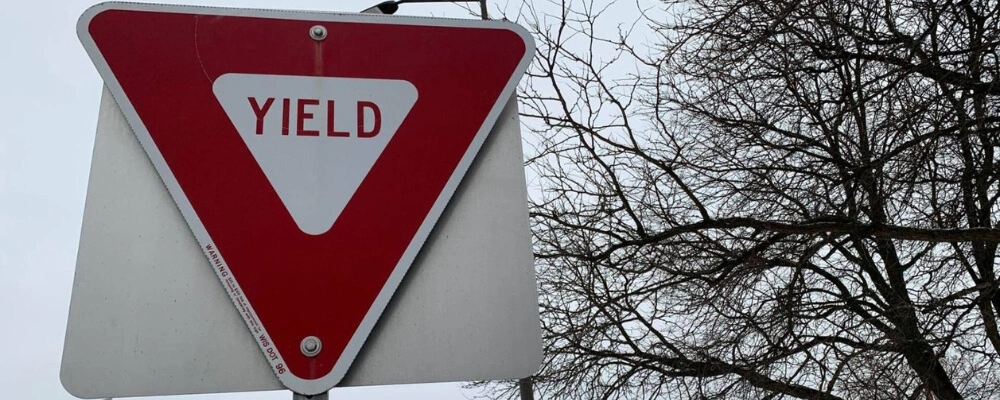
Yield Sign Purpose and Importance
The fundamental goal of road signs is to ensure the safe and efficient flow of traffic. Among these, the yield sign stands out as a critical tool, addressing the unique challenges of merging and intersecting traffic. The yield sign strikes a balance between the fluidity of traffic and safety, making it indispensable on roads around the world.
Preventing Accidents
Yield signs are primarily placed at intersections and merging lanes where the right-of-way might be unclear. By indicating which vehicle needs to give way, these signs play a crucial role in preventing potential collisions. By yielding the right-of-way, drivers can ensure that traffic from another direction can pass safely.
Managing Traffic Flow
One of the main advantages of a yield sign over a stop sign is the potential for smoother traffic flow. At a yield sign, drivers only need to stop if necessary. If the way is clear, drivers can continue without a full stop, ensuring a more fluid traffic flow and reducing potential congestion at intersections.
Difference Between a Stop Sign and a Yield Sign
Stop signs and yield signs are both traffic control signs used to regulate the flow of traffic at intersections and other points on the road. However, they serve different purposes and have distinct meanings:
1. Command
- Stop Sign: Drivers are required to make a full stop, regardless of the traffic conditions. After stopping, they can proceed when it’s safe.
- Yield Sign: Drivers need to slow down and prepare to stop but only need to come to a complete stop if there’s cross traffic or pedestrians. If the way is clear, they can continue without stopping.
2. Placement
- Stop Sign: Typically used at intersections where there’s a high volume of traffic or a significant risk of accidents. It ensures every vehicle stops and assesses the situation before proceeding.
- Yield Sign: Commonly found at merging lanes on highways, roundabouts, or intersections with less cross-traffic. Its goal is to keep traffic moving smoothly while ensuring safety.
3. Traffic Flow
- Stop Sign: This can potentially cause minor traffic delays as every vehicle must stop.
- Yield Sign: Promotes a more continuous flow of traffic, causing fewer delays as vehicles only stop when necessary.
In essence, while both signs prioritize safety, the yield sign offers a degree of flexibility, making it suitable for situations where the continuous flow of traffic is beneficial. Recognizing the distinction between these two signs and understanding their purposes is essential for safe driving.
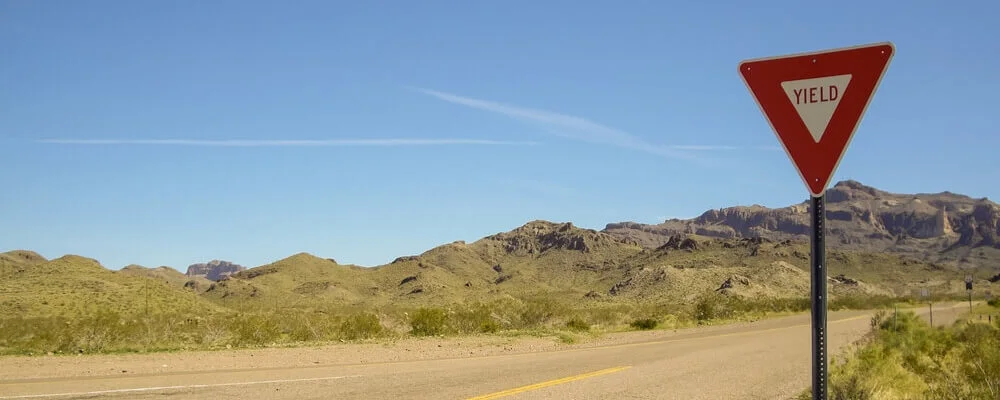
Understanding the Yield Sign
Navigating roads and intersections efficiently requires a clear understanding of various traffic signs, and the yield sign is no exception. It plays a crucial role in guiding drivers on when and where they should give way to other road users.
What It Means for Drivers
- Slow Down: Upon approaching a yield sign, the first thing a driver must do is reduce their speed. This is important as it gives the driver ample time to assess the traffic conditions ahead.
- Prepare to Stop: While the yield sign does not always mean that a complete stop is necessary, drivers should be prepared to do so if the situation demands it. The primary intent is to ensure that the path is clear and safe to continue.
- Give the Right of Way: If there is traffic in the intersection or another vehicle is approaching from a different direction that has the right of way, the driver must wait and allow them to pass before proceeding.
Conditions Under Which a Driver Must Yield
- Traffic in an Intersection: If there are vehicles already in the intersection or approaching it more closely, the driver approaching the yield sign should give way.
- Merging onto a Different Road or Highway: When entering a roadway from a ramp or a different lane, drivers should yield to vehicles already on the main road.
- Pedestrians: In many jurisdictions, pedestrians have the right of way at crosswalks and intersections. If a pedestrian is present, drivers must yield, even if they are not directly in front of the vehicle.
- Bicycles: At intersections or bike crossings, drivers should yield to cyclists.
- Roundabouts: Vehicles already in the roundabout typically have the right of way, and those entering must yield.
- Emergency Vehicles: Drivers should always yield to emergency vehicles, such as ambulances, fire trucks, and police cars, when they have their sirens or flashing lights on.
- Buses or School Buses: In some regions, drivers may need to yield to buses that are merging back into traffic from a bus stop.
- Uncontrolled Intersections: In the absence of traffic signs or signals, drivers should yield to the vehicle that arrives first or to the vehicle on the right if they arrive simultaneously.
Understanding the yield sign and knowing when to give way is fundamental for road safety. It not only ensures a driver’s safety but also contributes to smoother traffic flow and reduces the risk of collisions.
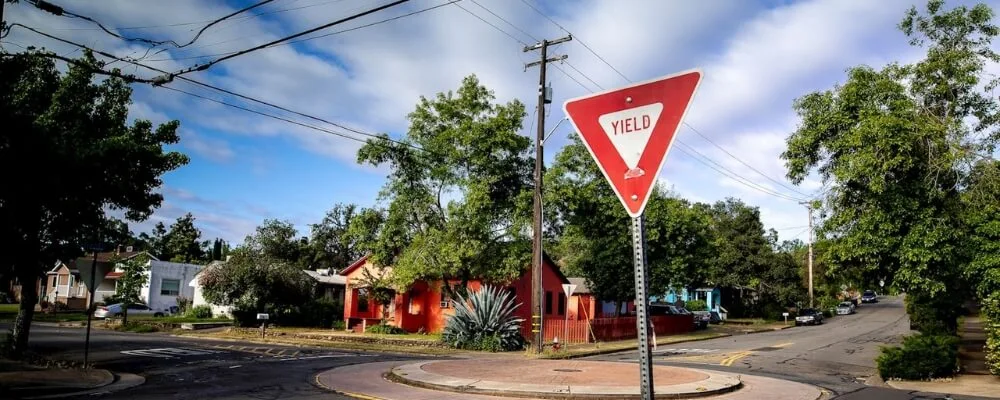
Placement and Positioning Of Yield Signs
The placement and positioning of traffic signs, including the yield sign, are meticulously strategized to enhance road safety. Proper positioning ensures clear visibility for drivers, allowing them sufficient time to interpret the sign and react accordingly.
Common Locations Where Yield Signs are Placed
- Intersections: Especially in places where one road has clear precedence over the other, yield signs are used to signal drivers on the secondary road to give way to traffic on the primary road.
- Roundabouts: Vehicles entering a roundabout are often signaled to yield to the traffic already circulating within the roundabout, ensuring smooth and accident-free flow.
- Freeway On-ramps: Before merging onto highways or freeways, drivers are often presented with a yield sign to ensure they give the right of way to the vehicles already on the main road.
- Mid-block Crosswalks: Yield signs may be placed at pedestrian crosswalks located in the middle of a block, signaling drivers to allow pedestrians to cross safely.
- T-Intersections: At these three-way intersections, the terminating road may have a yield sign to give way to vehicles on the continuing road.
- Blind Spots: At intersections or driveways with obstructed views, such as those surrounded by tall shrubs or buildings, yield signs help drivers navigate cautiously.
- Bridge or Narrow Roadways: On bridges or narrow passages where two-way traffic is difficult, one direction might have a yield sign to give way to the opposing traffic.
How Positioning Affects Visibility and Effectiveness
- Height: Yield signs are usually positioned at a height where they are easily visible to an average driver. Too low or too high might cause the sign to be overlooked.
- Angle: The angle of the sign must cater to oncoming drivers. It should be perpendicular to the direction of the approaching vehicle to ensure maximum visibility.
- Proximity to Road: The sign should be close enough to the road to be within the driver’s line of sight but far enough to avoid any accidental impacts.
- Clear of Obstructions: It’s essential to position the sign so it won’t be obscured by trees, lampposts, buildings, or other obstructions.
- Illumination: In areas with low visibility during nighttime or adverse weather conditions, yield signs might be illuminated or made with reflective material to make them stand out.
- Advance Warning: In certain scenarios, an additional yield sign or warning sign might be placed before the primary yield sign, giving drivers advanced notice, especially in high-speed areas.
Proper placement and positioning of yield signs are pivotal for their effectiveness. Misplaced or obscured signs can lead to confusion or be entirely overlooked, jeopardizing road safety. Properly positioned signs, on the other hand, offer clear instructions to drivers and play a crucial role in accident prevention.
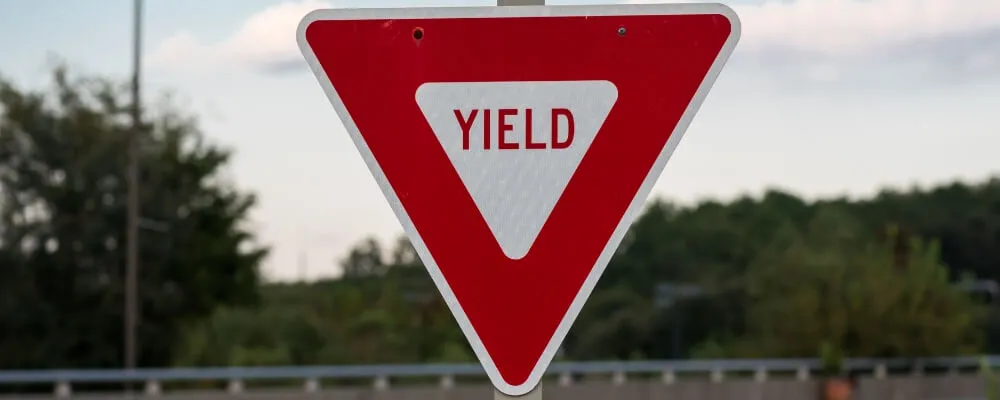
Yield Signs in Different Countries
Road signs, including yield signs, are a universal concept, yet their design and usage can vary from one country to another. This diversity is influenced by historical, cultural, and practical considerations.
Variations in Design
- Shape and Color: While the inverted triangle design is widely accepted, the color can vary. The U.S., Canada, and many other countries use a red-bordered triangle with white inside. In contrast, countries like South Africa have a yellow triangle.
- Wording: Some countries use symbols without words, while others include text. For instance, the U.S. simply uses the word “YIELD”, the UK uses “GIVE WAY”, and in Spain, you’d see “CEDA EL PASO”.
- Symbols: Some countries might incorporate additional symbols to clarify the sign’s meaning. For instance, a yield sign near a pedestrian crossing might include a pedestrian symbol.
Variations in Usage
- Roundabouts: In many European countries, vehicles entering the roundabout must yield to those already inside it. However, in some places like France, unless otherwise indicated, cars entering have the right of way.
- Intersections: The approach to uncontrolled intersections varies. In some countries, the vehicle on the right has the right of way, while in others, it’s the vehicle on the left.
Unique Rules or Customs Globally
- Bicycles and Pedestrians: In countries like the Netherlands, known for its biking culture, yield signs often cater explicitly to bicycles. Drivers may encounter signs instructing them to yield to cyclists.
- Cultural Practices: In some regions, even if a yield sign is present, it’s customary for drivers to give way to elders or livestock crossing the road.
- Language Variations: Non-English speaking countries will often have the yield sign in their language, but the design remains consistent for universal recognition. For example, in France, you’d see “CÉDEZ LE PASSAGE”.
- Regional Differences: Even within countries, there can be variations. For instance, in the US, while the rules for yield signs are federally standardized, nuances can differ from one state to another.
In conclusion, while the principle behind the yield sign is universally recognized, its design, wording, and application can vary widely across countries. This diversity underscores the importance of familiarizing oneself with local road signs and rules when traveling or relocating to a new country. Understanding these variations ensures safety and smoother transitions between different traffic systems.
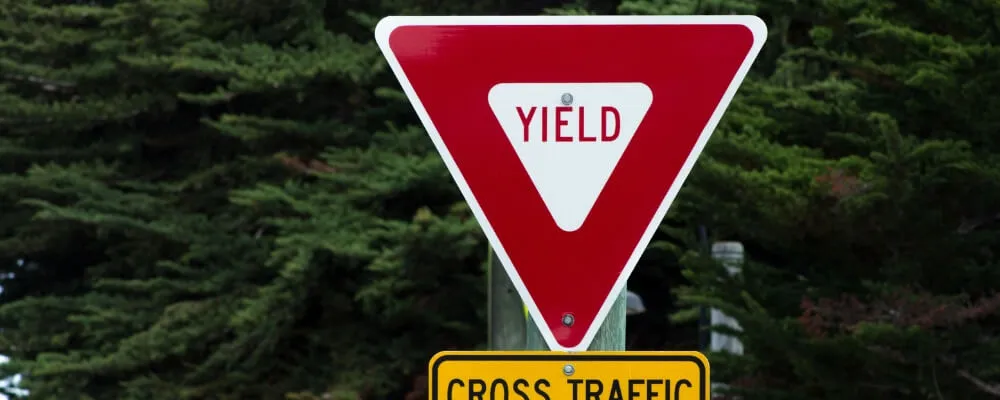
Yield Sign Safe Practices
Yield signs are crucial for maintaining the flow of traffic and preventing accidents. Understanding how to approach and react to them is an essential skill every driver must possess. Here are some safe practices and the potential consequences of neglecting them.
Tips for Drivers on How to Approach and React to a Yield Sign
- Slow Down: As soon as you spot a yield sign, reduce your speed. It gives you more time to judge the traffic situation.
- Scan the Area: Look for oncoming vehicles, pedestrians, or cyclists. Pay attention to all directions from which traffic might come.
- Prepare to Stop: While a yield sign isn’t a stop sign, you should be ready to come to a complete stop if necessary.
- Give Right of Way: If another vehicle, pedestrian, or cyclist is approaching, allow them to proceed first. Only continue when you’re sure it’s safe.
- Don’t Assume: Even if you have the right of way, don’t assume other drivers will yield to you. Always be cautious and prepared for unexpected behavior.
- Use Indicators: If you’re making a turn after yielding, ensure you use your indicators to communicate your intentions to other road users.
- Avoid Distractions: When approaching a yield sign, it’s crucial to be fully attentive. Avoid using your phone, fiddling with the radio, or any other distractions.
- Follow Lane Markings: Some yield situations might have additional lane markings. Make sure you understand and follow them.
Consequences of Not Yielding When Required
- Accidents: The most immediate and severe consequence of not yielding is the potential for a collision. This could involve vehicles, cyclists, or pedestrians.
- Traffic Disruptions: Failing to yield can cause disruptions in the smooth flow of traffic, leading to unnecessary congestion or bottlenecks.
- Legal Penalties: Not yielding can result in traffic violations. Depending on the jurisdiction, this could mean fines, demerit points, or even suspension of driving privileges in severe cases.
- Increased Insurance Rates: If you’re at fault in an accident due to not yielding, it might lead to an increase in your car insurance premium.
- Potential Harm: Apart from physical harm due to possible accidents, not yielding can also result in emotional and psychological distress for all parties involved, especially if injuries occur.
In summary, while yield signs might seem like simple traffic fixtures, they play a pivotal role in ensuring road safety. Adopting the right practices when approaching these signs and understanding the severe consequences of neglecting them will make for safer roads and a more enjoyable driving experience.
Conclusion
Throughout our exploration of the yield sign, we’ve seen how such a simple design can carry a weighty responsibility. It encapsulates the essence of road safety, reminding drivers of the importance of caution, consideration, and respect for others on the road. Understanding the nuances behind its design, placement, and significance goes beyond mere compliance; it’s about fostering a culture of attentive driving.
In different parts of the world, the yield sign might take on varying designs or be subject to unique regulations. Still, its core message remains unchanged: to prevent accidents and promote harmonious traffic flow. As we drive into the future, it’s crucial to remember the lessons this sign imparts. By adhering to the principles it represents, we not only ensure our safety but also contribute to a smoother, more efficient, and respectful driving environment for all.
Whether you’re navigating bustling city streets or tranquil country roads, let the yield sign serve as a constant reminder of the balance between speed and caution, movement and stillness. In the end, safe driving isn’t just about reaching our destination but ensuring that everyone else does, too.

